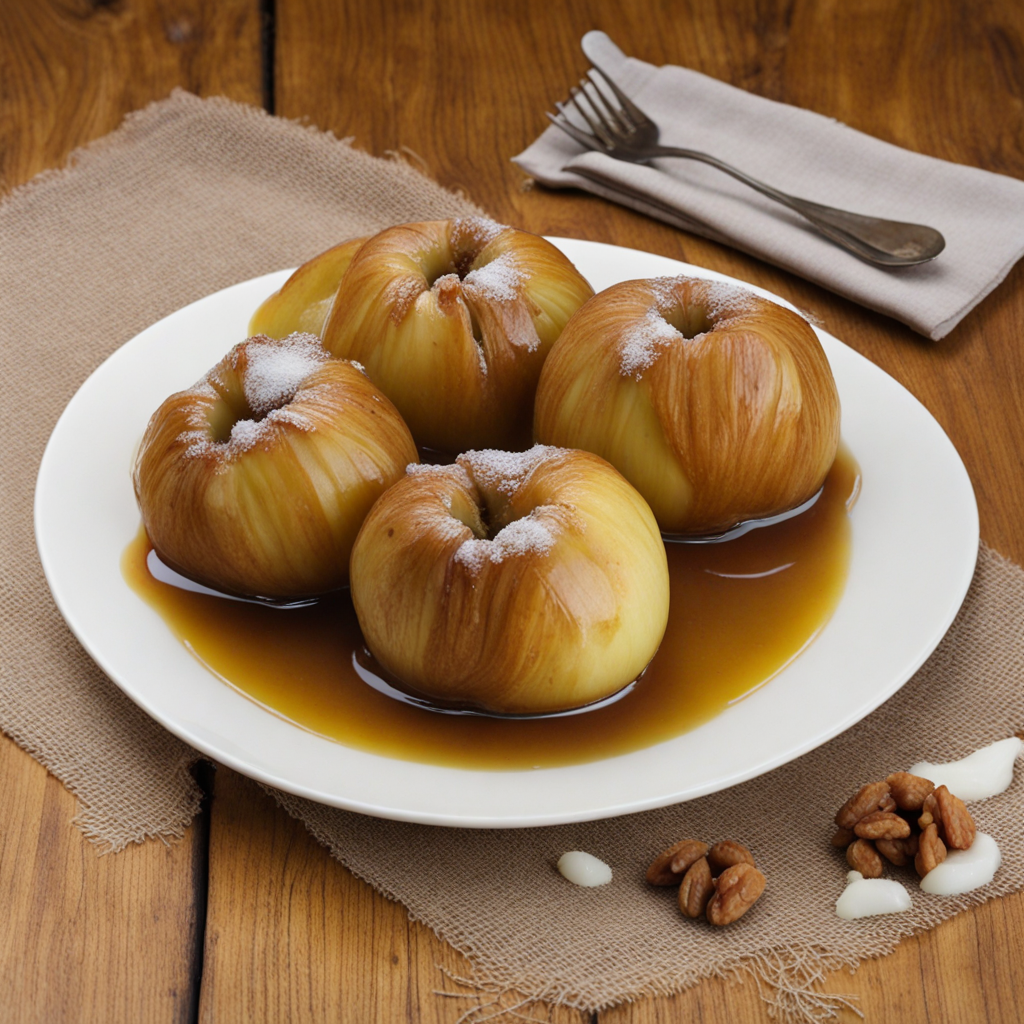Tufahije
Tufahije is a delightful Bosnian dessert that encapsulates the essence of the region's culinary traditions. At its core, Tufahije consists of poached apples, typically a variety called 'Winesap' or another sweet variety, which are hollowed out and filled with a rich mixture of ground walnuts, sugar, and cinnamon. The apples are then gently simmered in a sweet syrup, often flavored with lemon juice and a hint of vanilla, allowing them to absorb the syrup's flavors while becoming tender and succulent. This dessert is not just a feast for the taste buds but also a visual delight, often garnished with whipped cream or crushed nuts, creating an inviting presentation that is perfect for special occasions or family gatherings. The flavor profile of Tufahije is a harmonious blend of sweetness and nuttiness, where the natural sweetness of the apples complements the earthy, rich flavor of the walnuts. The cinnamon adds a warm and aromatic spice that elevates the dish, making each bite a comforting experience. The poaching process ensures that the apples retain their shape while becoming soft enough to melt in your mouth, offering a delightful contrast to the crunchy walnut filling. Each element works together to create a dessert that is both simple and sophisticated, capturing the heart of Bosnian flavors. Tufahije is not just a dessert; it's a cultural symbol in Bosnia and Herzegovina, often associated with family gatherings and festive celebrations. Its origins can be traced back to the Ottoman Empire, reflecting the rich history and diverse influences that have shaped Bosnian cuisine. Enjoying Tufahije is an experience that invites you to explore the warmth of Bosnian hospitality, as it is often served during holidays and special events, making it a cherished tradition. With its unique combination of flavors and textures, Tufahije is a must-try for anyone looking to expand their palate and discover the sweet side of Bosnian culinary heritage.
How It Became This Dish
The Sweet Legacy of Tufohije: A Culinary Gem of Bosnia and Herzegovina Origins: A Confluence of Cultures Tufohije, a traditional Bosnian dessert, is a delightful concoction that encapsulates the rich tapestry of Bosnian culinary heritage. Originating in the Ottoman Empire, tufohije is a dish of poached apples stuffed with a sweet mixture of walnuts, sugar, and spices such as cinnamon and clove. The name itself derives from the Turkish word “tufahi,” which means apple, underscoring the fruit's significance in the region's cuisine. The roots of tufohije can be traced back to the 15th century when the Ottomans began to influence the culinary landscape of the Balkans. Apples were a staple fruit in Ottoman gardens, and their versatility made them a favored ingredient in both savory and sweet dishes. The blending of local ingredients with Ottoman culinary techniques led to the emergence of various regional specialties, tufohije being one of the most cherished. Cultural Significance: A Symbol of Hospitality and Celebration In Bosnia and Herzegovina, food transcends mere sustenance; it is a vital part of social interaction and cultural identity. Tufohije embodies these values, often served during family gatherings, festive occasions, and religious celebrations. The dessert is particularly prominent during Ramadan, as it aligns with the spirit of generosity and hospitality that characterizes the month. The act of preparing tufohije is also steeped in tradition. Families often come together to make this dessert, passing down recipes and techniques through generations. The process of stuffing the apples and poaching them in sweet syrup becomes a communal activity, reinforcing family bonds and cultural heritage. Tufohije is not just a dessert; it is a symbol of warmth, love, and the importance of sharing food with others. Additionally, tufohije has found its place in the broader narrative of Bosnian cuisine, which reflects the country’s complex history. The interplay of different cultures—Ottoman, Austro-Hungarian, and Slavic—has shaped Bosnia’s culinary scene, and tufohije stands as a testament to this rich heritage. The dessert is often served alongside other traditional dishes like baklava and tufahija, creating a harmonious blend of flavors that celebrates the region's diverse history. Development Over Time: From Traditional to Contemporary As Bosnia and Herzegovina transitioned through various political and cultural phases, so too did the preparation and presentation of tufohije. In the early 20th century, the dessert was primarily homemade, with families adhering to traditional recipes. However, as the country entered the modern era, culinary practices began to evolve. The post-war period in the 1990s saw a resurgence in interest in traditional Bosnian cuisine, including tufohije. Chefs and home cooks alike began to explore the dessert's versatility, experimenting with different fillings and presentation styles. While the classic walnut filling remains popular, variations have emerged that incorporate ingredients like chocolate, dried fruits, or even modern twists such as caramel sauces. In recent years, tufohije has gained recognition beyond the borders of Bosnia. Food enthusiasts and chefs have begun to showcase this traditional dessert at international culinary festivals, introducing it to a global audience. Its unique flavor profile and cultural significance have sparked interest among food lovers, leading to its inclusion in contemporary Bosnian restaurants and cafes. Moreover, the rise of social media has played a pivotal role in the promotion of tufohije. Platforms like Instagram and Facebook have allowed home cooks and chefs to share their culinary creations, inspiring others to try their hand at making this beloved dessert. The visual appeal of tufohije—glazed apples glistening with syrup, adorned with crushed nuts and a sprinkle of cinnamon—has made it a popular subject for food photography, further cementing its place in modern culinary culture. Conclusion: A Timeless Sweetness Tufohije is more than just a dessert; it is a symbol of Bosnia and Herzegovina’s rich culinary heritage, a narrative woven through time. From its origins in the Ottoman Empire to its modern-day interpretations, tufohije captures the essence of Bosnian culture—one that values tradition, hospitality, and the joy of sharing food. As the world becomes increasingly interconnected, traditional dishes like tufohije remind us of the importance of preserving culinary heritage while embracing innovation. The sweet, spiced flavors of tufohije continue to resonate with people, inviting them to experience a taste of Bosnia's history and warmth. In a rapidly changing culinary landscape, tufohije stands resilient, a testament to the enduring power of food to unite, celebrate, and honor the past. Whether enjoyed in a family home, a bustling cafe, or at a festive gathering, tufohije remains a cherished delicacy, sweetening the hearts and lives of those who partake in its delightful flavors.
You may like
Discover local flavors from Bosnia And Herzegovina







